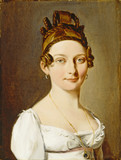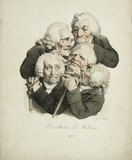Born in the northeastern region of France near the Flemish border, Louis-Léopold Boilly received his first training in art from his father, the sculptor Arnould-Polycarpe Boilly. By 1779, following his studies at the Augustinian prior at Douai, the young artist was in Arras, where he painted more than three hundred portraits. Boilly settled in Paris in 1785 and became a popular painter of gallant subjects. Popularized by engravings, these slightly risqué, teasing scenes of the intrigues and snares of the game of love were avidly collected. The frivolity of his subjects, however, brought him into conflict with the authorities during the Reign of Terror. He was saved from prison and possible execution by the discovery in his home of preparatory drawings for The Triumph of Marat, c. 1794 (Versailles), celebrating the Revolutionary martyr murdered in 1792. Boilly specialized in portraiture and genre painting, depicting fashionable contemporary Parisian society in precisely detailed and smoothly finished paintings that owe much to Dutch and Flemish seventeenth-century paintings. Boilly exhibited at the Salon of the Louvre after 1791, when it was opened to all artists. He received a first-class medal in 1804, and in 1833 was awarded the Légion d’honneur by King Louis-Philippe. Married twice, Boilly fathered six children, one of whom was the painter Eugène Boilly.
Louis-Léopold Boilly
8 records
Include records without images
About this artist



